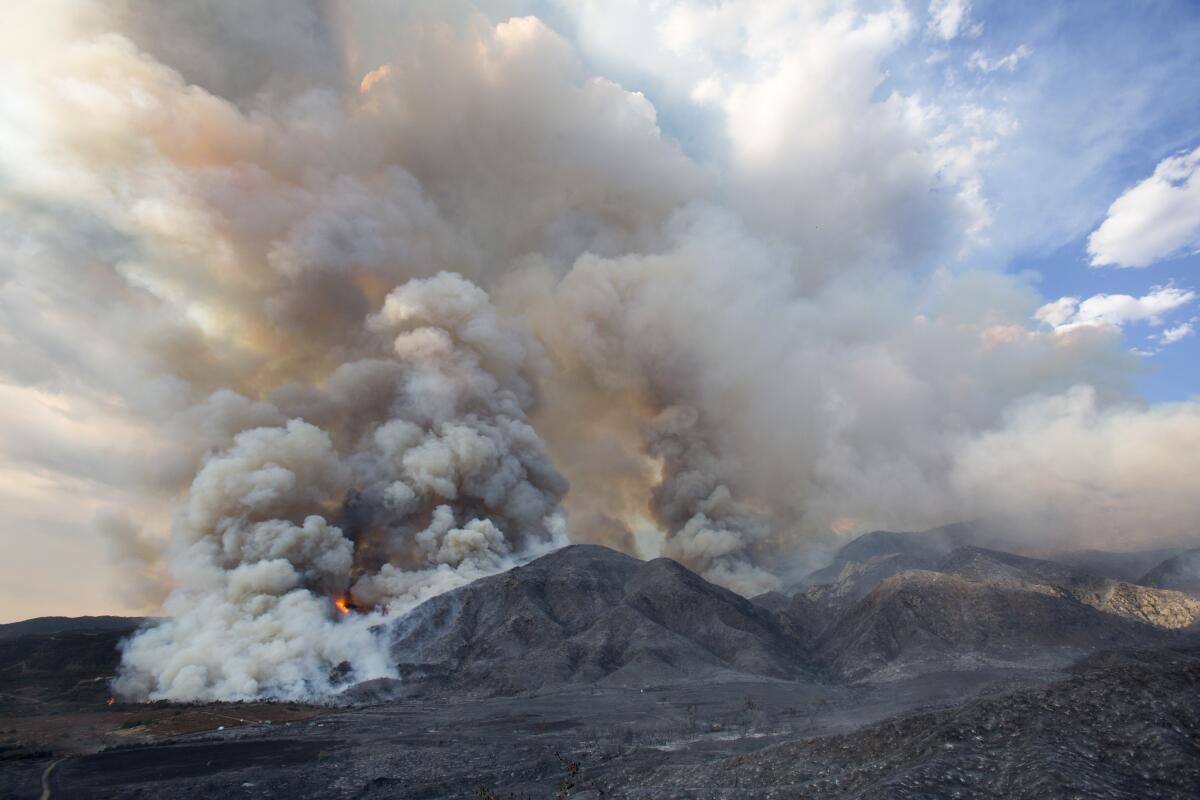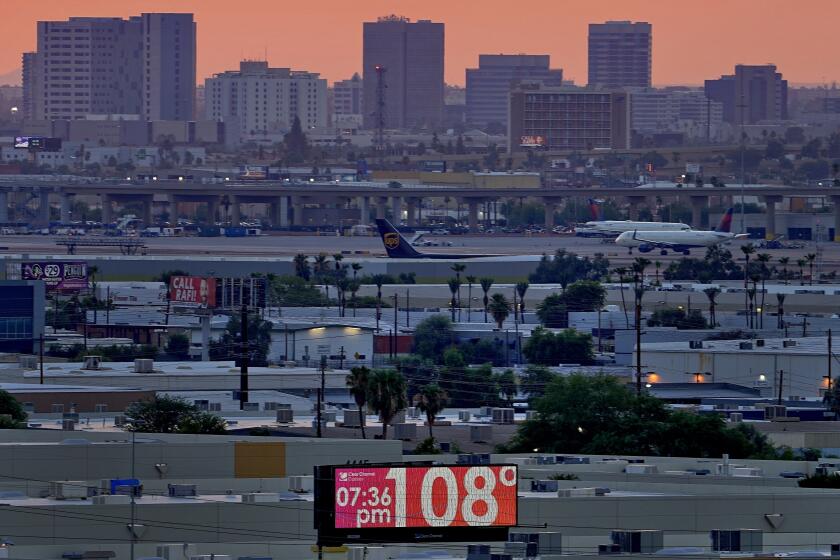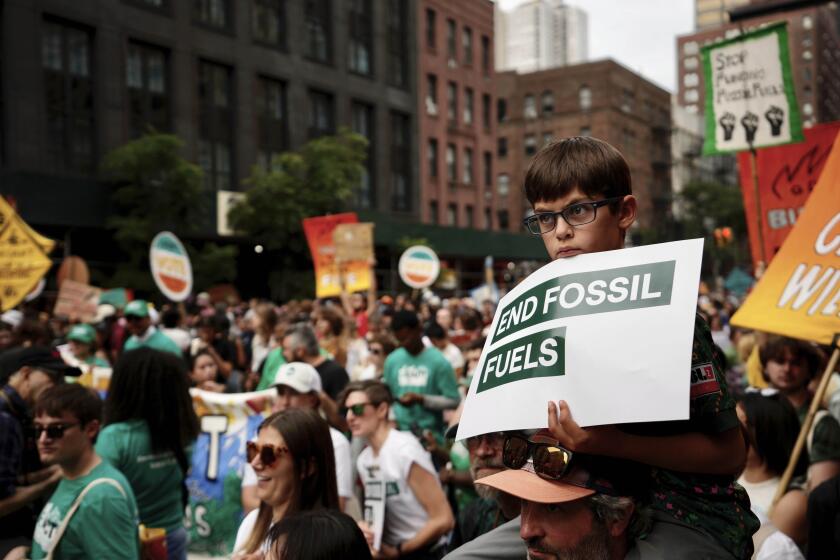California’s greenhouse gas emissions are rising — and we’re not even counting them all

- Share via
California has committed to substantially reducing its greenhouse gas emissions, aiming for carbon neutrality by 2045. The pledge is key to Gov. Gavin Newsom’s claims of climate leadership, which featured prominently in his recent visits to China and the United Nations.
But the California Air Resources Board recently released a preliminary greenhouse gas inventory suggesting the state’s emissions increased slightly last year compared with the previous year. This is of course bad news, since addressing climate change requires deep and swift emissions reductions.
What I’m even more concerned about, however, is that the state’s greenhouse gas inventory undercounts emissions in the first place. Although the issue seldom gets attention, California’s inventory excludes emissions from a variety of sources, including wildfires and industrial sectors such as shipping, aviation and biofuels.
Some of the world’s most populous places, including parts of India, Pakistan and the Middle East, face extended intolerable conditions.
Imagine a smoker who promises to quit but continues to make broad exceptions for smoking at work and social events. Regardless of what the smoker tells the doctor, their lungs will reflect the truth.
California’s greenhouse gas inventory is likewise not just going in the wrong direction but also ignoring a lot of harmful sources of emissions. Indeed, the state even measures and lists some of these emissions in its reports. But they’re not counted toward its overall greenhouse gas footprint, which it uses to attest to its efforts to combat climate change.
These omitted emissions have serious consequences: Relying on CARB’s estimates alone, the state’s reported greenhouse gas footprint would be about 20% greater if it included its omitted emissions. And that doesn’t include the emissions the agency doesn’t even list in its inventory, such as those from wildfires, which are largely human-caused, measurable and manageable.
Medicine has conflict of interest policies that, while imperfect, help lessen the influence of industry in putting profits and self-interest over science and health.
The omissions also have repercussions for California communities. Many of the industries whose greenhouse gas emissions are excluded from the official inventory — including shipping, aviation, refineries and biofuels — produce additional pollutants that affect nearby communities. People living near these facilities are harmed by that pollution regardless of whether officials choose to count those facilities’ emissions. Particularly in communities with historical and continuing environmental injustices, these omissions compound the problem.
The city of Stockton, for example, agreed to produce a greenhouse gas inventory as part of a settlement of a lawsuit alleging that its general plan did not adequately consider environmental impacts. Yet its greenhouse gas inventory excludes emissions from the very industries that contribute to local air pollution and environmental injustices. In fact, the emissions excluded by the city are four times greater than those it reported.
These emissions omissions are not unique to California. Indeed, national governments exclude international shipping and aviation emissions from reports to the United Nations required by the Paris agreement, relying partly on outdated and politicized methodologies.
While the Paris agreement allows for such omissions, it doesn’t prevent countries from improving their accounting methods. What’s more, subnational governments such as California’s are not parties to the agreement and therefore not bound to its methodologies. In fact, unlike its national counterparts, California once counted transportation emissions from biofuels such as ethanol but reclassified them in 2016.
Nor is this issue confined to governments: Corporate emitters are also part of the problem. One study found that technology companies’ greenhouse gas declarations undercounted their emissions, sometimes by orders of magnitude. And corporate “net zero” pledges often arbitrarily count emissions in ways that don’t amount to actual reductions.
What’s the solution? Only a full account of greenhouse gas emissions can allow us to appropriately attribute responsibility to each emitter and determine its progress in reducing its contributions to climate change. We need greenhouse gas accounting systems that are rigorous, complete and interoperable.
This is a daunting task but not a hopeless one. Senate Bill 253, which Newsom recently signed into law, requires large corporations operating in California to disclose their greenhouse gas emissions and include emissions throughout their supply chains. That’s critical: Disclosing emissions across supply chains will help hold emitters responsible for their complete greenhouse gas footprints.
While SB 253 is a very good first step, the Air Resources Board should apply the same standard to the state’s greenhouse gas inventory. Measuring California’s complete footprint requires including upstream and downstream refinery emissions as well as those from aviation, shipping, biofuels and wildfires.
Getting greenhouse gas accounting right is ultimately crucial to dealing with climate change. Until governments and corporations completely and accurately account for their contributions to the problem, their promised solutions will fall short.
Leehi Yona is a JD-PhD candidate and Knight-Hennessy Scholar at Stanford University whose research has focused on greenhouse gas emissions accounting.
More to Read
A cure for the common opinion
Get thought-provoking perspectives with our weekly newsletter.
You may occasionally receive promotional content from the Los Angeles Times.











